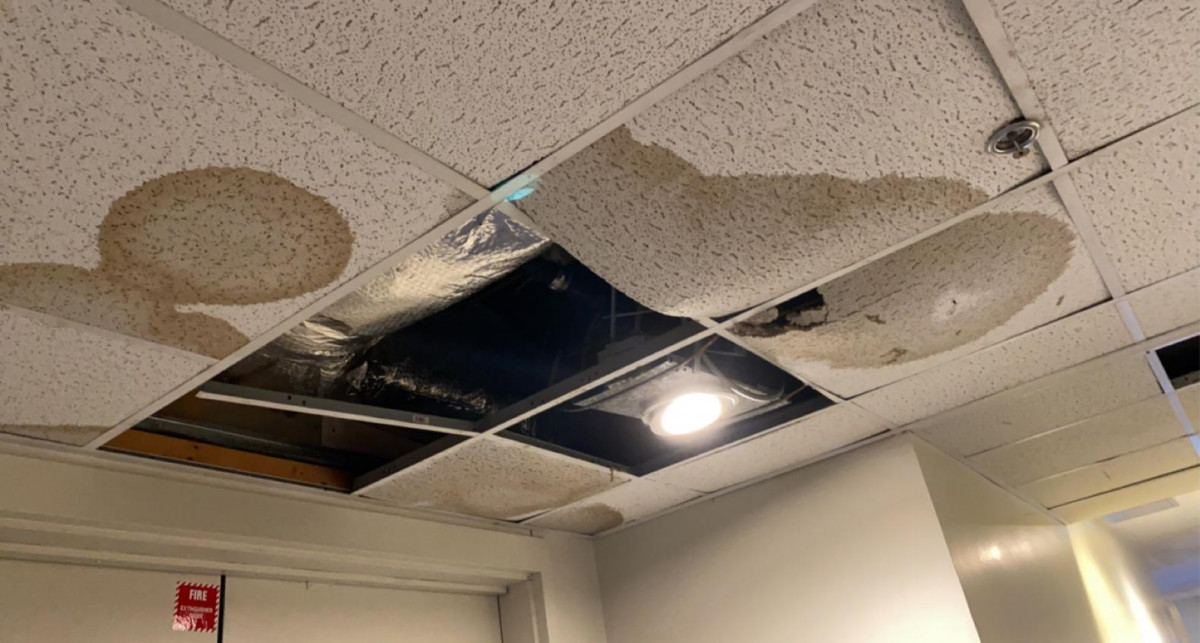(Photo courtesy of Kyra Barry) “The flooding damage to building permeated every floor below four.”
Kyra Barry
Connector Editor
On February 4th of this semester, Sheehy flooded after a pipe burst. All floors from the fourth floor down were affected, and the building was evacuated while the damage was triaged. Renovations continue today, and according to Mike Bliss, associate director of residence life for housing logistics, 62 affected students have been moved out of Sheehy for the rest of the semester.
As for what exactly happened, Bliss said that a window was left ajar over the weekend when temperatures dropped below zero, and since it was in a stairwell that wasn’t used often, no one noticed that the main water pipe froze until after it burst. “The pipe froze and the ends popped off between floors two and three, and three and four, and water rushed out from it. We don’t have an estimate of the total amount of water, but enough water over a couple [of] hours caused enough damage to about a dozen rooms from that point downward.”
“Student rooms had the least amount of [damage],” said Bliss, explaining that because of the way the building is set up and how the pipe burst, the affected stairwell was flooded first, followed by the hallways and finally the student rooms. By then, the water had been partially absorbed by the carpet after passing through these locations.
“The biggest damage to students was just whatever they had on the floor and that from our experience and walking through the suites myself, it was mostly clothes. We collected those clothes if students wanted and paid to have them cleaned and returned, and we have done so for the students to come and pick them up already.”
For preventive measures, resident advisors are being encouraged to take rounds outside of the building so that open windows and the like won’t be missed instead of having to rely on remembering which stairwell was already checked. Bliss said, “I think our efforts were good in terms of being preventative and in having no student windows open. We had no damage from that.”
Bliss outlined roughly the steps that are being taken to address the flooding in Sheehy. Starting with triage, HVAC and other emergency services are getting rid of the water using dryers, fans and dehumidifiers since water causes the most long-term damage. “But to do that in some cases, we had to open up walls and water moves over time. So there just becomes a kind of an unknown of what we’re going to find. So we have to go through the process of putting the machines in and having crews go in and continue to treat and we get more information as time goes.”
“Most of that [damage] was rugs needing to be ripped up and the next most was hallways, especially the third and second and first floor hallways directly under that stairwell, [where] water goes down and out as it goes down gravity-wise. A lot of rugs had to be torn up and then we had to rip up some of the baseboards. If you walk through Sheehy, you’ll see kind of a cut from about two feet, like [up to] your knees, down to the floor cut out of the drywall because it got wet and water got in behind [it].”
Renovations are projected to continue into the summer months. For students still living in the building, they should be able to circumvent workers by going up floors. No work should be done directly in front of student dorms, as much of the work is to be done in front of the unoccupied dorms of evacuated students.
Students who moved into new dorms are paying the same amount that they would in Sheehy, even if they were living in a more expensive building. UMass Lowell has different rate brackets for different dorms, with Sheehy being in the second cheapest bracket. If students moved into a lower-priced dorm after this incident, their housing bill would be changed to reflect that. “So they’ll never pay more and many are paying less.”




